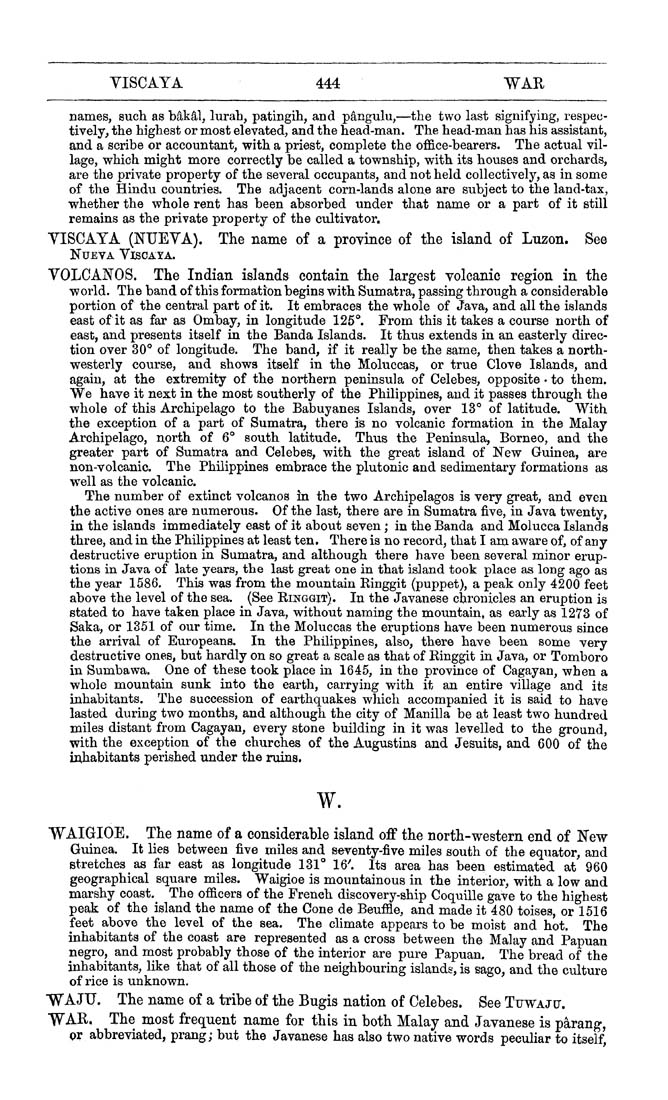VISCAYA 444 WAR
names, such as b^k^l, lurah, patingih, and pangulu,—the two last signifying, respec¬
tively, the highest or most elevated, and the head-man. The head-man has his assistant,
and a scribe or accountant, with a priest, complete the ofi&ce-bearers. The actual vil¬
lage, which might more correctly be called a township, with its houses and orchards,
are the private property of the several occupants, and not held collectively, as in some
of the Hindu countries. The adjacent corn-lands alone are subject to the land-tax,
whether the whole rent has been absorbed under that name or a part of it still
remains as the private property of the cultivator,
VISCAYA (NUEVA). The name of a province of the island of Luzon. See
Nueva Viscaya.
VOLCANOS. The Indian islands contain the largest volcanic region in the
world. The band of this formation begins with Sumatra, passing through a considerable
portion of the central part of it. It embraces the whole of Java, and all the islands
east of it as far as Ombay, in longitude 125°. From this it takes a course north of
east, and presents itself in the Banda Islands. It thus extends in an easterly direc¬
tion over SO*' of longitude. The band, if it really be the same, then takes a north¬
westerly course, and shows itself in the Moluccas, or true Clove Islands, and
again, at the extremity of the northern peninsula of Celebes, opposite • to them.
We have it next in the most southerly of the Philippines, and it passes through the
whole of this Archipelago to the Babuyanes Islands, over 13° of latitude. With
the exception of a part of Sumatra, there is no volcanic formation in the Malay
Archipelago, north of 6° south latitude. Thus the Peninsula, Borneo, and the
greater part of Sumatra and Celebes, with the great island of New Guinea, are
non-volcanic. The Philippines embrace the plutonic and sedimentary formations as
well as the volcanic.
The number of extinct volcanos in the two Archipelagos is very great, and even
the active ones are numerous. Of the last, there are in Sumatra five, in Java twenty,
in the islands immediately east of it about seven; in the Banda and Molucca Islands
three, and in the Philippines at least ten. There is no record, that I am aware of, of any
destructive eruption in Sumatra, and although there have been several minor erup¬
tions in Java of late years, the last great one in that island took place as long ago as
the year 1586. This was from the mountain Ringgit (puppet), a peak only 4200 feet
above the level of the sea. (See Ringgit). In the Javanese chronicles an eruption is
stated to have taken place in Java, without naming the mountain, as early as 1273 of
Saka, or 1351 of our time. In the Moluccas the eruptions have been numerous since
the arrival of Europeans. In the Philippines, also, there have been some very
destructive ones, but hardly on so great a scale as that of Ringgit in Java, or Tomboro
in Sumbawa. One of these took place in 1645, in the province of Cagayan, when a
whole mountain sunk into the earth, carrying with it an entire village and its
inhabitants. The succession of earthquakes which accompanied it is said to have
lasted during two months, and although the city of Manilla be at least two hundred
miles distant from Cagayan, every stone building in it was levelled to the ground,
with the exception of the churches of the Augustins and Jesuits, and 600 of the
inhabitants perished under the ruins.
w.
WAIGIOE. The name of a considerable island off the north-western end of New
Guinea. It lies between five miles and seventy-five miles south of the equator, and
stretches as far east as longitude 131° 16'. Its area has been estimated at 960
geographical square miles. Waigioe is mountainous in the interior, with a low and
marshy coast. The ofiacers of the French discovery-ship Coquille gave to the highest
peak of the island the name of the Cone de Beufiae, and made it 480 toises, or 1516
feet above the level of the sea. The climate appears to be moist and hot. The
inhabitants of the coast are represented as a cross between the Malay and Papuan
negro, and niost probably those of the interior are pure Papuan. The bread of the
inhabitants, like that of all those of the neighbouring islands, is sago, and the culture
of rice is unknown.
"WAJU. The name of a tribe of the Bugis nation of Celebes. See Tuwaju.
"WAR. The most frequent name for this in both Malay and Javanese is parang,
or abbreviated, prang; but the Javanese has also two native words pecuHar to itself.
|








